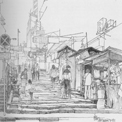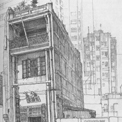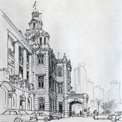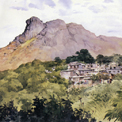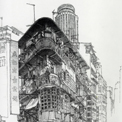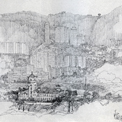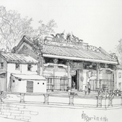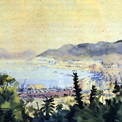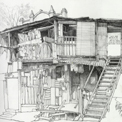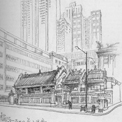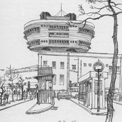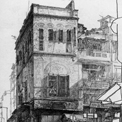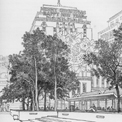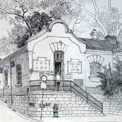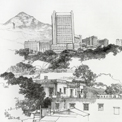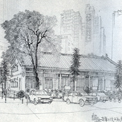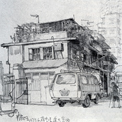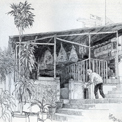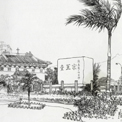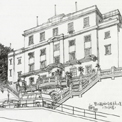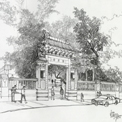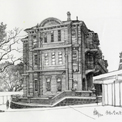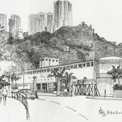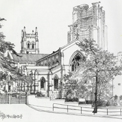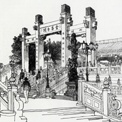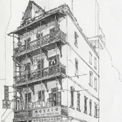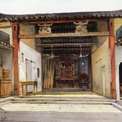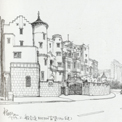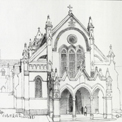The old Chi Kung Temple, Wan Chai
According to Chinese folk tales, Chi Kung was a living Buddha. He was very charitable, saving people from miseries, and lived a humble life. Though he ate and drank like anyone who was not a buddhist, he contended that the wine and good food could not lead him away from the Buddhist doctrine. It was believed that a great bubonic plague broke out in 1894 in Hong Kong, and people who lived in the area of Wanchai prayed to Chi Kung that he would save the people from this plague. Amazingly, their prayers were answered, and the people built a temple to honour him. Because of the current redevelopment plan in the Wanchai area, the Chi Kung Temple that was formerly on Queen's Road East was moved to the Tin Hau Temple on Tai Ping Shan Street in Sheung Wan.
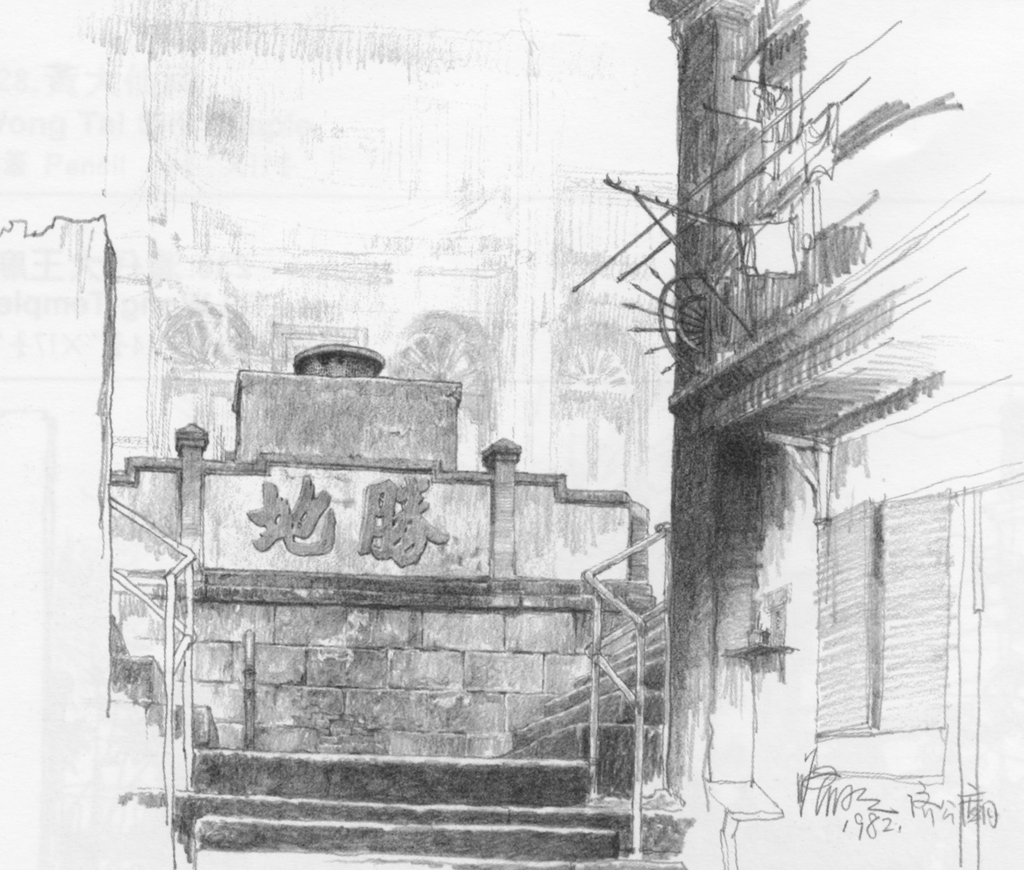
| Date | 1982 |
| Place | Hong Kong Island/Wan Chai District/Wan Chai/(Street)/Chi Kung Temple |
| people | Kong Kai Ming |
| Material Type | Image |
| Collection | Sketches by Kong Kai-ming |
| Source | Kong, Kai Ming. Landmarks of Hong Kong: Further Artistic Impression. (Hong Kong: The School of Continuing Education, Hong Kong Baptist University, 1994), p.184 |
| Repository | The University of Hong Kong Libraries |
| Note to Copyright | Permission for use is given by Kong Kai Ming |
| Accession No. | LA005-329 |
The old Chi Kung Temple, Wan Chai
According to Chinese folk tales, Chi Kung was a living Buddha. He was very charitable, saving people from miseries, and lived a humble life. Though he ate and drank like anyone who was not a buddhist, he contended that the wine and good food could not lead him away from the Buddhist doctrine. It was believed that a great bubonic plague broke out in 1894 in Hong Kong, and people who lived in the area of Wanchai prayed to Chi Kung that he would save the people from this plague. Amazingly, their prayers were answered, and the people built a temple to honour him. Because of the current redevelopment plan in the Wanchai area, the Chi Kung Temple that was formerly on Queen's Road East was moved to the Tin Hau Temple on Tai Ping Shan Street in Sheung Wan.
| Date | 1982 |
| Place | Hong Kong Island/Wan Chai District/Wan Chai/(Street)/Chi Kung Temple |
| People | Kong Kai Ming |
| Material Type | Image |
| Collection | Sketches by Kong Kai-ming |
| Source | Kong, Kai Ming. Landmarks of Hong Kong: Further Artistic Impression. (Hong Kong: The School of Continuing Education, Hong Kong Baptist University, 1994), p.184 |
| Repository | The University of Hong Kong Libraries |
| Note to Copyright | Permission for use is given by Kong Kai Ming |
| Accession No. | LA005-329 |
The old Chi Kung Temple, Wan Chai
According to Chinese folk tales, Chi Kung was a living Buddha. He was very charitable, saving people from miseries, and lived a humble life. Though he ate and drank like anyone who was not a buddhist, he contended that the wine and good food could not lead him away from the Buddhist doctrine. It was believed that a great bubonic plague broke out in 1894 in Hong Kong, and people who lived in the area of Wanchai prayed to Chi Kung that he would save the people from this plague. Amazingly, their prayers were answered, and the people built a temple to honour him. Because of the current redevelopment plan in the Wanchai area, the Chi Kung Temple that was formerly on Queen's Road East was moved to the Tin Hau Temple on Tai Ping Shan Street in Sheung Wan.
| Date | 1982 |
| Place | Hong Kong Island/Wan Chai District/Wan Chai/(Street)/Chi Kung Temple |
| People | Kong Kai Ming |
| Material Type | Image |
| Collection | Sketches by Kong Kai-ming |
| Source | Kong, Kai Ming. Landmarks of Hong Kong: Further Artistic Impression. (Hong Kong: The School of Continuing Education, Hong Kong Baptist University, 1994), p.184 |
| Repository | The University of Hong Kong Libraries |
| Note to Copyright | Permission for use is given by Kong Kai Ming |
| Accession No. | LA005-329 |
The old Chi Kung Temple, Wan Chai
According to Chinese folk tales, Chi Kung was a living Buddha. He was very charitable, saving people from miseries, and lived a humble life. Though he ate and drank like anyone who was not a buddhist, he contended that the wine and good food could not lead him away from the Buddhist doctrine. It was believed that a great bubonic plague broke out in 1894 in Hong Kong, and people who lived in the area of Wanchai prayed to Chi Kung that he would save the people from this plague. Amazingly, their prayers were answered, and the people built a temple to honour him. Because of the current redevelopment plan in the Wanchai area, the Chi Kung Temple that was formerly on Queen's Road East was moved to the Tin Hau Temple on Tai Ping Shan Street in Sheung Wan.
| Date | 1982 |
| Place | Hong Kong Island/Wan Chai District/Wan Chai/(Street)/Chi Kung Temple |
| People | Kong Kai Ming |
| Material Type | Image |
| Collection | Sketches by Kong Kai-ming |
| Source | Kong, Kai Ming. Landmarks of Hong Kong: Further Artistic Impression. (Hong Kong: The School of Continuing Education, Hong Kong Baptist University, 1994), p.184 |
| Repository | The University of Hong Kong Libraries |
| Note to Copyright | Permission for use is given by Kong Kai Ming |
| Accession No. | LA005-329 |
The old Chi Kung Temple, Wan Chai
According to Chinese folk tales, Chi Kung was a living Buddha. He was very charitable, saving people from miseries, and lived a humble life. Though he ate and drank like anyone who was not a buddhist, he contended that the wine and good food could not lead him away from the Buddhist doctrine. It was believed that a great bubonic plague broke out in 1894 in Hong Kong, and people who lived in the area of Wanchai prayed to Chi Kung that he would save the people from this plague. Amazingly, their prayers were answered, and the people built a temple to honour him. Because of the current redevelopment plan in the Wanchai area, the Chi Kung Temple that was formerly on Queen's Road East was moved to the Tin Hau Temple on Tai Ping Shan Street in Sheung Wan.
| Date | 1982 |
| People | Kong Kai Ming |
| Material Type | Image |
| Collection | Sketches by Kong Kai-ming |
| Source | Kong, Kai Ming. Landmarks of Hong Kong: Further Artistic Impression. (Hong Kong: The School of Continuing Education, Hong Kong Baptist University, 1994), p.184 |
| Repository | The University of Hong Kong Libraries |
| Note to Copyright | Permission for use is given by Kong Kai Ming |
| Accession No. | LA005-329 |
The old Chi Kung Temple, Wan Chai
According to Chinese folk tales, Chi Kung was a living Buddha. He was very charitable, saving people from miseries, and lived a humble life. Though he ate and drank like anyone who was not a buddhist, he contended that the wine and good food could not lead him away from the Buddhist doctrine. It was believed that a great bubonic plague broke out in 1894 in Hong Kong, and people who lived in the area of Wanchai prayed to Chi Kung that he would save the people from this plague. Amazingly, their prayers were answered, and the people built a temple to honour him. Because of the current redevelopment plan in the Wanchai area, the Chi Kung Temple that was formerly on Queen's Road East was moved to the Tin Hau Temple on Tai Ping Shan Street in Sheung Wan.
| Date | 1982 |
| Place | Hong Kong Island/Wan Chai District/Wan Chai/(Street)/Chi Kung Temple |
| People | Kong Kai Ming |
| Material Type | Image |
| Collection | Sketches by Kong Kai-ming |
| Source | Kong, Kai Ming. Landmarks of Hong Kong: Further Artistic Impression. (Hong Kong: The School of Continuing Education, Hong Kong Baptist University, 1994), p.184 |
| Repository | The University of Hong Kong Libraries |
| Note to Copyright | Permission for use is given by Kong Kai Ming |
| Accession No. | LA005-329 |
The old Chi Kung Temple, Wan Chai
According to Chinese folk tales, Chi Kung was a living Buddha. He was very charitable, saving people from miseries, and lived a humble life. Though he ate and drank like anyone who was not a buddhist, he contended that the wine and good food could not lead him away from the Buddhist doctrine. It was believed that a great bubonic plague broke out in 1894 in Hong Kong, and people who lived in the area of Wanchai prayed to Chi Kung that he would save the people from this plague. Amazingly, their prayers were answered, and the people built a temple to honour him. Because of the current redevelopment plan in the Wanchai area, the Chi Kung Temple that was formerly on Queen's Road East was moved to the Tin Hau Temple on Tai Ping Shan Street in Sheung Wan.
| Date | 1982 |
| Place | Hong Kong Island/Wan Chai District/Wan Chai/(Street)/Chi Kung Temple |
| People | Kong Kai Ming |
| Material Type | Image |
| Collection | Sketches by Kong Kai-ming |
| Source | Kong, Kai Ming. Landmarks of Hong Kong: Further Artistic Impression. (Hong Kong: The School of Continuing Education, Hong Kong Baptist University, 1994), p.184 |
| Repository | The University of Hong Kong Libraries |
| Note to Copyright | Permission for use is given by Kong Kai Ming |
| Accession No. | LA005-329 |
The old Chi Kung Temple, Wan Chai
According to Chinese folk tales, Chi Kung was a living Buddha. He was very charitable, saving people from miseries, and lived a humble life. Though he ate and drank like anyone who was not a buddhist, he contended that the wine and good food could not lead him away from the Buddhist doctrine. It was believed that a great bubonic plague broke out in 1894 in Hong Kong, and people who lived in the area of Wanchai prayed to Chi Kung that he would save the people from this plague. Amazingly, their prayers were answered, and the people built a temple to honour him. Because of the current redevelopment plan in the Wanchai area, the Chi Kung Temple that was formerly on Queen's Road East was moved to the Tin Hau Temple on Tai Ping Shan Street in Sheung Wan.
| Date of Death | 1982 |
| Place | Hong Kong Island/Wan Chai District/Wan Chai/(Street)/Chi Kung Temple |
| People | Kong Kai Ming |
| Material Type | Image |
| Collection | Sketches by Kong Kai-ming |
| Source | Kong, Kai Ming. Landmarks of Hong Kong: Further Artistic Impression. (Hong Kong: The School of Continuing Education, Hong Kong Baptist University, 1994), p.184 |
| Repository | The University of Hong Kong Libraries |
| Note to Copyright | Permission for use is given by Kong Kai Ming |
| Accession No. | LA005-329 |
The old Chi Kung Temple, Wan Chai
According to Chinese folk tales, Chi Kung was a living Buddha. He was very charitable, saving people from miseries, and lived a humble life. Though he ate and drank like anyone who was not a buddhist, he contended that the wine and good food could not lead him away from the Buddhist doctrine. It was believed that a great bubonic plague broke out in 1894 in Hong Kong, and people who lived in the area of Wanchai prayed to Chi Kung that he would save the people from this plague. Amazingly, their prayers were answered, and the people built a temple to honour him. Because of the current redevelopment plan in the Wanchai area, the Chi Kung Temple that was formerly on Queen's Road East was moved to the Tin Hau Temple on Tai Ping Shan Street in Sheung Wan.
| Date | 1982 |
| Material Type | Image |
| Collection | Sketches by Kong Kai-ming |
| Source | Kong, Kai Ming. Landmarks of Hong Kong: Further Artistic Impression. (Hong Kong: The School of Continuing Education, Hong Kong Baptist University, 1994), p.184 |
| Note to Copyright | Permission for use is given by Kong Kai Ming |
| Accession No. | LA005-329 |
The old Chi Kung Temple, Wan Chai
According to Chinese folk tales, Chi Kung was a living Buddha. He was very charitable, saving people from miseries, and lived a humble life. Though he ate and drank like anyone who was not a buddhist, he contended that the wine and good food could not lead him away from the Buddhist doctrine. It was believed that a great bubonic plague broke out in 1894 in Hong Kong, and people who lived in the area of Wanchai prayed to Chi Kung that he would save the people from this plague. Amazingly, their prayers were answered, and the people built a temple to honour him. Because of the current redevelopment plan in the Wanchai area, the Chi Kung Temple that was formerly on Queen's Road East was moved to the Tin Hau Temple on Tai Ping Shan Street in Sheung Wan.
| Date | 1982 |
| Material Type | Image |
| Place | Hong Kong Island/Wan Chai District/Wan Chai/(Street)/Chi Kung Temple |
| People | Kong Kai Ming |
| Collection | Sketches by Kong Kai-ming |
| Source | Kong, Kai Ming. Landmarks of Hong Kong: Further Artistic Impression. (Hong Kong: The School of Continuing Education, Hong Kong Baptist University, 1994), p.184 |
| Repository | The University of Hong Kong Libraries |
| Note to Copyright | Permission for use is given by Kong Kai Ming |
| Accession No. | LA005-329 |
The old Chi Kung Temple, Wan Chai
According to Chinese folk tales, Chi Kung was a living Buddha. He was very charitable, saving people from miseries, and lived a humble life. Though he ate and drank like anyone who was not a buddhist, he contended that the wine and good food could not lead him away from the Buddhist doctrine. It was believed that a great bubonic plague broke out in 1894 in Hong Kong, and people who lived in the area of Wanchai prayed to Chi Kung that he would save the people from this plague. Amazingly, their prayers were answered, and the people built a temple to honour him. Because of the current redevelopment plan in the Wanchai area, the Chi Kung Temple that was formerly on Queen's Road East was moved to the Tin Hau Temple on Tai Ping Shan Street in Sheung Wan.
| Date | 1982 |
| Place | Hong Kong Island/Wan Chai District/Wan Chai/(Street)/Chi Kung Temple |
| People | Kong Kai Ming |
| Material Type | Image |
| Collection | Sketches by Kong Kai-ming |
| Source | Kong, Kai Ming. Landmarks of Hong Kong: Further Artistic Impression. (Hong Kong: The School of Continuing Education, Hong Kong Baptist University, 1994), p.184 |
| Repository | The University of Hong Kong Libraries |
| Note to Copyright | Permission for use is given by Kong Kai Ming |
| Accession No. | LA005-329 |
The old Chi Kung Temple, Wan Chai
According to Chinese folk tales, Chi Kung was a living Buddha. He was very charitable, saving people from miseries, and lived a humble life. Though he ate and drank like anyone who was not a buddhist, he contended that the wine and good food could not lead him away from the Buddhist doctrine. It was believed that a great bubonic plague broke out in 1894 in Hong Kong, and people who lived in the area of Wanchai prayed to Chi Kung that he would save the people from this plague. Amazingly, their prayers were answered, and the people built a temple to honour him. Because of the current redevelopment plan in the Wanchai area, the Chi Kung Temple that was formerly on Queen's Road East was moved to the Tin Hau Temple on Tai Ping Shan Street in Sheung Wan.
| Date | 1982 |
| Place | Hong Kong Island/Wan Chai District/Wan Chai/(Street)/Chi Kung Temple |
| People | Kong Kai Ming |
| Material Type | Image |
| Collection | Sketches by Kong Kai-ming |
| Source | Kong, Kai Ming. Landmarks of Hong Kong: Further Artistic Impression. (Hong Kong: The School of Continuing Education, Hong Kong Baptist University, 1994), p.184 |
| Repository | The University of Hong Kong Libraries |
| Note to Copyright | Permission for use is given by Kong Kai Ming |
| Accession No. | LA005-329 |
The old Chi Kung Temple, Wan Chai
According to Chinese folk tales, Chi Kung was a living Buddha. He was very charitable, saving people from miseries, and lived a humble life. Though he ate and drank like anyone who was not a buddhist, he contended that the wine and good food could not lead him away from the Buddhist doctrine. It was believed that a great bubonic plague broke out in 1894 in Hong Kong, and people who lived in the area of Wanchai prayed to Chi Kung that he would save the people from this plague. Amazingly, their prayers were answered, and the people built a temple to honour him. Because of the current redevelopment plan in the Wanchai area, the Chi Kung Temple that was formerly on Queen's Road East was moved to the Tin Hau Temple on Tai Ping Shan Street in Sheung Wan.
| Date | 1982 |
| Place | Hong Kong Island/Wan Chai District/Wan Chai/(Street)/Chi Kung Temple |
| People | Kong Kai Ming |
| Material Type | Image |
| Collection | Sketches by Kong Kai-ming |
| Source | Kong, Kai Ming. Landmarks of Hong Kong: Further Artistic Impression. (Hong Kong: The School of Continuing Education, Hong Kong Baptist University, 1994), p.184 |
| Repository | The University of Hong Kong Libraries |
| Note to Copyright | Permission for use is given by Kong Kai Ming |
| Accession No. | LA005-329 |
The old Chi Kung Temple, Wan Chai
According to Chinese folk tales, Chi Kung was a living Buddha. He was very charitable, saving people from miseries, and lived a humble life. Though he ate and drank like anyone who was not a buddhist, he contended that the wine and good food could not lead him away from the Buddhist doctrine. It was believed that a great bubonic plague broke out in 1894 in Hong Kong, and people who lived in the area of Wanchai prayed to Chi Kung that he would save the people from this plague. Amazingly, their prayers were answered, and the people built a temple to honour him. Because of the current redevelopment plan in the Wanchai area, the Chi Kung Temple that was formerly on Queen's Road East was moved to the Tin Hau Temple on Tai Ping Shan Street in Sheung Wan.
| Date | 1982 |
| Place | Hong Kong Island/Wan Chai District/Wan Chai/(Street)/Chi Kung Temple |
| People | Kong Kai Ming |
| Material Type | Image |
| Collection | Sketches by Kong Kai-ming |
| Source | Kong, Kai Ming. Landmarks of Hong Kong: Further Artistic Impression. (Hong Kong: The School of Continuing Education, Hong Kong Baptist University, 1994), p.184 |
| Repository | The University of Hong Kong Libraries |
| Note to Copyright | Permission for use is given by Kong Kai Ming |
| Accession No. | LA005-329 |
The old Chi Kung Temple, Wan Chai
According to Chinese folk tales, Chi Kung was a living Buddha. He was very charitable, saving people from miseries, and lived a humble life. Though he ate and drank like anyone who was not a buddhist, he contended that the wine and good food could not lead him away from the Buddhist doctrine. It was believed that a great bubonic plague broke out in 1894 in Hong Kong, and people who lived in the area of Wanchai prayed to Chi Kung that he would save the people from this plague. Amazingly, their prayers were answered, and the people built a temple to honour him. Because of the current redevelopment plan in the Wanchai area, the Chi Kung Temple that was formerly on Queen's Road East was moved to the Tin Hau Temple on Tai Ping Shan Street in Sheung Wan.
| Date | 1982 |
| Place | Hong Kong Island/Wan Chai District/Wan Chai/(Street)/Chi Kung Temple |
| People | Kong Kai Ming |
| Material Type | Image |
| Collection | Sketches by Kong Kai-ming |
| Source | Kong, Kai Ming. Landmarks of Hong Kong: Further Artistic Impression. (Hong Kong: The School of Continuing Education, Hong Kong Baptist University, 1994), p.184 |
| Repository | The University of Hong Kong Libraries |
| Note to Copyright | Permission for use is given by Kong Kai Ming |
| Accession No. | LA005-329 |
The old Chi Kung Temple, Wan Chai
According to Chinese folk tales, Chi Kung was a living Buddha. He was very charitable, saving people from miseries, and lived a humble life. Though he ate and drank like anyone who was not a buddhist, he contended that the wine and good food could not lead him away from the Buddhist doctrine. It was believed that a great bubonic plague broke out in 1894 in Hong Kong, and people who lived in the area of Wanchai prayed to Chi Kung that he would save the people from this plague. Amazingly, their prayers were answered, and the people built a temple to honour him. Because of the current redevelopment plan in the Wanchai area, the Chi Kung Temple that was formerly on Queen's Road East was moved to the Tin Hau Temple on Tai Ping Shan Street in Sheung Wan.
| Date | 1982 |
| Place | Hong Kong Island/Wan Chai District/Wan Chai/(Street)/Chi Kung Temple |
| People | Kong Kai Ming |
| Material Type | Image |
| Collection | Sketches by Kong Kai-ming |
| Source | Kong, Kai Ming. Landmarks of Hong Kong: Further Artistic Impression. (Hong Kong: The School of Continuing Education, Hong Kong Baptist University, 1994), p.184 |
| Repository | The University of Hong Kong Libraries |
| Note to Copyright | Permission for use is given by Kong Kai Ming |
| Accession No. | LA005-329 |
The old Chi Kung Temple, Wan Chai
According to Chinese folk tales, Chi Kung was a living Buddha. He was very charitable, saving people from miseries, and lived a humble life. Though he ate and drank like anyone who was not a buddhist, he contended that the wine and good food could not lead him away from the Buddhist doctrine. It was believed that a great bubonic plague broke out in 1894 in Hong Kong, and people who lived in the area of Wanchai prayed to Chi Kung that he would save the people from this plague. Amazingly, their prayers were answered, and the people built a temple to honour him. Because of the current redevelopment plan in the Wanchai area, the Chi Kung Temple that was formerly on Queen's Road East was moved to the Tin Hau Temple on Tai Ping Shan Street in Sheung Wan.
| Date | 1982 |
| Place | Hong Kong Island/Wan Chai District/Wan Chai/(Street)/Chi Kung Temple |
| People | Kong Kai Ming |
| Material Type | Image |
| Collection | Sketches by Kong Kai-ming |
| Source | Kong, Kai Ming. Landmarks of Hong Kong: Further Artistic Impression. (Hong Kong: The School of Continuing Education, Hong Kong Baptist University, 1994), p.184 |
| Repository | The University of Hong Kong Libraries |
| Note to Copyright | Permission for use is given by Kong Kai Ming |
| Accession No. | LA005-329 |
The old Chi Kung Temple, Wan Chai
According to Chinese folk tales, Chi Kung was a living Buddha. He was very charitable, saving people from miseries, and lived a humble life. Though he ate and drank like anyone who was not a buddhist, he contended that the wine and good food could not lead him away from the Buddhist doctrine. It was believed that a great bubonic plague broke out in 1894 in Hong Kong, and people who lived in the area of Wanchai prayed to Chi Kung that he would save the people from this plague. Amazingly, their prayers were answered, and the people built a temple to honour him. Because of the current redevelopment plan in the Wanchai area, the Chi Kung Temple that was formerly on Queen's Road East was moved to the Tin Hau Temple on Tai Ping Shan Street in Sheung Wan.
| Date | 1982 |
| Place | Hong Kong Island/Wan Chai District/Wan Chai/(Street)/Chi Kung Temple |
| People | Kong Kai Ming |
| Material Type | Image |
| Collection | Sketches by Kong Kai-ming |
| Source | Kong, Kai Ming. Landmarks of Hong Kong: Further Artistic Impression. (Hong Kong: The School of Continuing Education, Hong Kong Baptist University, 1994), p.184 |
| Repository | The University of Hong Kong Libraries |
| Note to Copyright | Permission for use is given by Kong Kai Ming |
| Accession No. | LA005-329 |
Copyright © 2012 Hong Kong Memory



